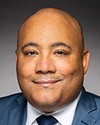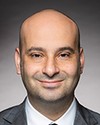Mr. Speaker, I am very happy to participate in the debate on this split border bill, Bill C-12.
My riding of Niagara South is a border riding. The town of Fort Erie borders the city of Buffalo. The connection between Canada and the United States in my riding runs deep in our DNA. Everyone I know in every part of my riding has ties to western New York. Crossing the Peace Bridge was like simply crossing the street. Relationships and, indeed, every aspect of our region are, or were, tied to something or someone in the Buffalo or Niagara Falls, New York area. We cheered for the Sabres, of course, unless the Leafs were in town, in which case the KeyBank Center in Buffalo was often filled with a majority of Canadians. We were part of the Bills Mafia and lined up to cross the bridge to tailgate with our American friends.
We do not so much anymore. I am incredibly saddened by the current issues we are facing: trade disputes, tariffs and the strain and stress those are placing on literally thousands of people employed in my riding because we are a border community. Our cross-border business ties have become part of the very bone structure of Niagara South. Niagara South is a great example of what can be built with strong trade links and binational and international commerce.
I spent a lifetime in the local business community helping people grow their enterprises, commercialize their products and find markets in and outside Canada. We have struggled over the past 10 years with the brain drain of ideas flowing south to where capital is more readily available. Recent market machinations mean that our already-weakened innovation sector is at even greater risk. We are in a kind of economic purgatory right now. We have caved to Donald Trump after a decade of missed opportunities, failed industrial and innovation policy and declining productivity. We are now watching the Stellantis deal literally implode before our eyes, losing a long-term key investment and 3,000 jobs. This is a massive failure. There are repercussions to our trade failure, which the Prime Minister said is a rupture. It is an interesting case study in economic impotence.
Canadians want solutions, but the government has proposed none. The silence on the file, outside of platitudes and bold but meaningless political hyperbole, tells me that the guy who said he could deal with Trump is appeasing him or simply hoping to wait him out. The guy who said he would engage in nation-building projects simply announced old ones.
In my riding, the Peace Bridge is one of the most critical border crossings in Canada, facilitating over $50 billion in trade every year. Tourism from our American friends also drove our local economy.
An issue that came up during the election relates again, to the Peace Bridge in Fort Erie. Transport Canada invested $5 million, and the Peace Bridge authority also invested $5 million, to build new infrastructure to scan commercial vehicles leaving Canada. This is called the Peace Bridge pre-arrival readiness evaluation project, or PARE.
Multi-energy portal technology exists to scan the contents of trailers, containers and vehicles while the vehicle continues to move at around 10 kilometres an hour through the scanning lanes. It identifies what is actually inside these vehicles. We know that only a small percentage of containers in the major ports in Canada are actually inspected. This is why thousands of stolen cars are being exported to distant criminal markets.
This MEP technology is universally used in southern U.S. ports of entry and exit and can provide a full inventory of contents within a minute or two. This technology is not new, but for some reason Canada has dropped the ball on this in the most egregious way. Canada and taxpayers invested $10 million to build the infrastructure for this scanning equipment at the base of the Peace Bridge on the Canadian side two years ago. Guess what. The United States government invested $30 million, literally giving us this technology here in Canada. All we had to do was build the infrastructure, and we did.
Unfortunately, Canadian bureaucracy has held this project up because we cannot seem to get the Canadian nuclear regulatory authority to green-light the technology, a technology already safely and widely deployed around the world.
For over a year now, this infrastructure has lain unused at the base of the Peace Bridge and the scanning equipment has sat in storage somewhere in Baltimore, waiting for the Canadian government to live up to its end of the bargain. This technology is pretty amazing. Using state-of-the-art scanning, we can get a full history of the trucks that cross the border, such as driving records, the track record of the company crossing, e-manifest verifications and facial recognition for matching driver identity. We get a complete data package on the vehicle in minutes. This expedites trade and safety. It lowers emissions and commercial congestion. It expedites the identification of contraband and stolen goods.
Last week, I heard a minister across say something about scanning equipment being put into the budget, but I am not sure who it was. If this technology is being considered, my question is this: What took the government so long?
The government is talking big about beefing up our security at borders. This bill is supposed to have a major role in this, but we have been standing on the shoreline of this project and missed the proverbial boat to solve one of the most pressing problems plaguing Canadians right now: the theft and export of stolen vehicles. Even ministers of the Crown are not immune to this, one having had his vehicle stolen twice. The anxiety Canadians feel over the lack of response to this epidemic is palpable. We no longer feel safe in our safe zones and neighbourhoods.
The Prime Minister was in Niagara last week reannouncing old announcements. I would bet a dollar or two that he had no idea this technology was sitting at the base of the Peace Bridge. If he really wanted to look at game-changing opportunities, he would have stood there and fixed the bureaucratic logjam. Instead, he regurgitated old announcements and called it news.
I wrote to the Minister of Public Safety, the Minister of Energy and Natural Resources and the Minister of Transport in July urging them to get involved and fast-track this technology out of the bureaucratic logjam. Four months later, it is crickets. Is it any wonder Trump is taking advantage of us? We cannot even launch a project that is already built.
What about those 1,000 new jobs at the border? We have been hearing about these extra 1,000 border officers, a high-profile announcement with zero action. I have qualified constituents who have been waiting for months after applying with no response and no callback. No one at the CBSA has an idea of how this can be done. There is simply not enough training capacity.
There are other issues facing the CBSA that need to be fixed. Suicide rates in the organization have rocked its members. We need to pay attention to the entire cultural structure before making absurd political announcements.
Finally, I need to talk about one very serious issue related to this bill. Proposed section 6 requires operators of international border crossings, like the Peace Bridge in Fort Erie and the Rainbow Bridge in Niagara Falls, to provide existing, new or significantly expanded assets free of charge to the CBSA upon a simple request.
The Peace Bridge, unlike others in Canada, is owned by and operated through a binational authority, with no taxpayer or public funding. The operations of the bridge are managed through independent revenue streams or, in simple terms, tolls. This legislation imposes a blanket requirement on the Government of Canada to demand investment in new infrastructure without a financial contribution. This is an open-ended and serious flaw in the legislation. What it means directly is that, for non-federally owned or controlled border bridges, the only way to pay for capital expansion for federal freebies is through tolls.
There are federally owned bridges, such as Blue Water Bridge, Thousand Islands Bridge and Seaway International Bridge. Under proposed section 6, the costs would be borne by the government because it owns these border crossings, which is not the case with the Peace Bridge. This is a classic government download on the consumer and a lack of organizational understanding. Worse, it manifestly disregards the interests of local residents. The government needs to look at this unfair provision and make changes to ensure there is a level playing field. The legislation imposes a double standard.
There is so much more I could talk about regarding this bill, but time does not permit. There are serious issues to fix here. I hope the government will pay attention to the points I have raised. My riding's economy, people, businesses and jobs are inextricably linked to Canada and U.S. trade. Please let there be no absurd reannouncements of old projects. We have real problems to fix.










